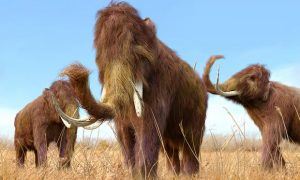Steven Poole in The Guardian:
 It’s harder than you might think to make a dinosaur. In Jurassic Parkthey do it by extracting a full set of dinosaur DNA from a mosquito preserved in amber, and then cloning it. But DNA degrades over time, and to date none has been found in a prehistoric mosquito or a dinosaur fossil. The more realistic prospect is to take a live dinosaur you have lying around already: a bird. Modern birds are considered a surviving line of theropod dinosaurs, closely related to the T rex and velociraptor. (Just look at their feet: “theropod” means “beast-footed”.) By tinkering with how a bird embryo develops, you can silence some of its modern adaptations and let the older genetic instructions take over. Enterprising researchers have already made a chicken with a snout instead of a beak.
It’s harder than you might think to make a dinosaur. In Jurassic Parkthey do it by extracting a full set of dinosaur DNA from a mosquito preserved in amber, and then cloning it. But DNA degrades over time, and to date none has been found in a prehistoric mosquito or a dinosaur fossil. The more realistic prospect is to take a live dinosaur you have lying around already: a bird. Modern birds are considered a surviving line of theropod dinosaurs, closely related to the T rex and velociraptor. (Just look at their feet: “theropod” means “beast-footed”.) By tinkering with how a bird embryo develops, you can silence some of its modern adaptations and let the older genetic instructions take over. Enterprising researchers have already made a chicken with a snout instead of a beak.
This obviously adds to the general merriment of the world, and will eventually kickstart a roaring trade in exotic quasi-Jurassic pets. But there are a surprising number of other projects that aim to bring back more recently vanished wild animals, from the woolly mammoth to the Pyrenean ibex. Advances in gene-editing technology promise to make “de‑extinction” a potentially viable enterprise, but what exactly is the point? To answer this question, the Swedish science journalist Torill Kornfeldt has travelled to meet the researchers involved for this excellent book, written with a deceptively light touch (in Fiona Graham’s translation), that raises a number of deep questions and paradoxes about our relationship with nature.
More here.
